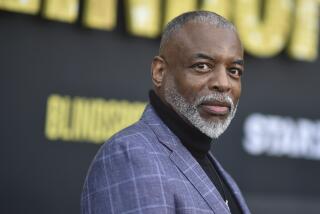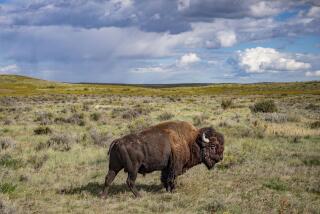MOVIE REVIEW : The Other Richard Burton
- Share via
Sir Richard Burton, the Victorian explorer, geologist, botanist, anthropologist, rake, poet, master of 40 languages and dialects, the first European to enter the sacred, forbidden Muslim citadel of Harer in East Africa, translator of the Kamasutra and the 16-volume “Arabian Nights”--is any life more cinematically enticing than his?
It’s mystifying that, until now, no one has sought to make a feature film about him, unless you want to count the 1971 TV docudrama “The Search for the Nile.” Burton’s career has enough material for 20 movies, all of them fascinating. Bob Rafelson, the director and co-writer, with William Harrison of “Mountains of the Moon” (at the AMC Century 14) has chosen to focus on Burton’s expeditions to trace the source of the Nile in Central Africa. In the process, they’ve scrunched Burton’s achievements and personality into a single movement. It’s a Burton Baedeker.
When the film opens, in 1854, on the East African Coast, Burton (Patrick Bergin) sets off on an exploration with three officers of the British East India Co., including John Henning Speke (Iain Glen), a somewhat effete species of gentry who proves to be a crack marksman. The men are forced to return to England after a native attack in which Burton has a javelin hurled through his jaw and Speke, badly injured, narrowly misses dismemberment. (The film is rated R for graphic violence and nudity.)
The second Burton/Speke go-round, a two-year ordeal begun in 1857, proceeds inland from Zanzibar. Captured by the tribe of the African despot Ngolo (Bheki Tonto Ngema), the two men and their entourage endure a waiting game of terror. When, at last, a measure of peace with the tribe has been made, Burton is content to loiter and sample its customs while Speke, obsessive about tracking the Nile, moves on and comes upon a great body of water, which he dubs Lake Victoria and which he is convinced is the Nile’s source.
Returning first to England, Speke stakes his claim with the Royal Geographical Society and is lionized, despite the fact that the claim is contested by Burton, who believes Lake Tanganyika to be the source. (Speke’s hunch eventually proved correct.) As the film slants it, Speke allows himself to willfully betray his friend for a shot at uncontested glory. Burton, egged on by his wife (the voracious Fiona Shaw), offers up a front of hurt bewilderment.
In reality, Burton was far more contemptuous of Speke’s claims. He was less equitable toward the natives in his company than we’re shown here. But, just as the film makers are pushing a somewhat repellent and soulless version of Speke, so are they also promoting a rather saintly and rehabilitated Burton. He’s less a swashbuckler sensualist of genius than a wronged good-guy.
Rafelson and Harrison, on whose biographical novel “Burton and Speke” the movie is largely based, clearly revere Burton. But they don’t build enough layers into the characterization--and certainly there are umpteen layers to be had. The almost domesticated Burton that we get simply doesn’t hold the screen, and Patrick Bergin, who has mostly appeared on stage and on television, doesn’t have the star-power reserves that would compensate for the lack. It’s not a matter of being a star: Peter O’Toole wasn’t one when he made “Lawrence of Arabia.” But the larger-than-life complexity of heroism was built into O’Toole’s every gesture, and that’s what’s missing from Bergin’s portrayal.
We don’t sense Burton’s, or the world’s, fever to discover the Nile’s source. We don’t sense this free spirit’s distaste for the colonialist usages of his explorations, or his revulsion--or attraction--for the colonialist in himself. We don’t really glimpse what he saw in Speke. Burton once described himself as “a blaze without focus,” but we don’t register the way Speke’s effete single-mindedness could hold him on track.
It’s a bit clearer what connected Speke to Burton. There’s a hero-worshippy enthrallment at work--an infatuation made explicit in one sequence when Speke, cradling the severely wounded Burton in his arms, kisses him full on the mouth. But it’s a throwaway moment--a footnote. For the most part, Rafelson and Harrison back off from a convincingly “modern” approach to these men’s lives; they dither in realms of ambiguity. Neither do they provide the old-fashioned psychological hokum that might at least have made entertaining all this strutting in the jungle.
Rafelson is on much firmer ground in his portrayal of the Africans. He’s a scrupulous and principled ethnographer, and he has a sure feeling for the beauty in the strong African faces and landscapes. The second expedition’s guide, Sidi Bombay (Paul Onsango), the runaway slave Mabruki (Delroy Lindo), and Ngolo, with his loping, panther-like prances, are more memorable, visually and emotionally, than Burton and Speke. The film’s funniest, and best, moment issues full-blown from the ethnography: The expedition confronts a tribe that, as a sign of friendship, spits liquid all over the white intruders’ faces. Burton’s men return the favor, get into the spirit of the spritzing. It’s as if we were witnessing the roots of slapstick.
Later on, there’s an almost equally good moment when Burton and the explorer David Livingstone, well played by Bernard Hill, compare their scars in a can-you-top-this disrobement. In retrospect, the two scenes work contrapuntally. Rafelson is harmonizing cultures, demonstrating that the African jungle and the Victorian drawing room aren’t all that far apart.
Films with the scale and historical scope of “Mountains of the Moon” are rarely made anymore, and certainly the action and the scenery and costumes are enough to keep you watching. The film is far from a disgrace, but it doesn’t rouse the senses or the intellect. What it does rouse is a nostalgia for what the greatest heroic-exploration movies have meant to us. Is the kind of physical and intellectual heroism that Sir Richard Burton embodied antiquated today? Or is it just that the film makers haven’t found the way to make his legend resonate for modern audiences?
More to Read
Only good movies
Get the Indie Focus newsletter, Mark Olsen's weekly guide to the world of cinema.
You may occasionally receive promotional content from the Los Angeles Times.








